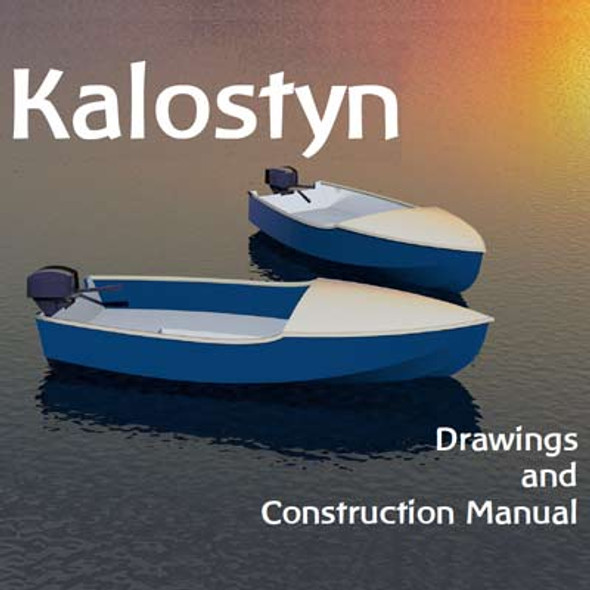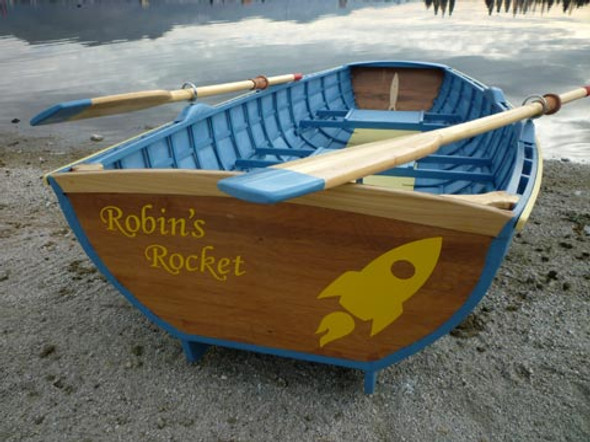Description
Free plans. To download the file, click HERE
Respected boat designer John Welsford challenged me with this brief:
'The kids, 9 and 11 had been hounding their dad (a fairly handy guy with tools) for a boat of their own for ages. The family's 30 footer was too much for them of course but they lusted after a boat of their own. One day the 11 year old came into dads workshop like a cat with a rabbit, dragging an old sailboard rig asking, "Dad, can you build us a boat? Look I've got the sail and everything." '
Naturally, it got me thinking. My kids are a few years away from their 11th and 9th birthdays, but this scenario is not too hard to imagine and could well be with us soon.
Being a parent, my first question is this: 'OK - where did you get that sail young fella?' Having sorted that one out to my satisfaction, I think there's little doubt that I'd build the boat. The rig accounts for a large fraction of the work involved in a small boat, and if the lad's spent his pocket money on a usable second-hand sailboarder's foil... Well! How could I say no?

Now a lad of 11 years and a girl of 9 years want something that's faster than the boats their peers are sailing - or at least it must be able to keep up with them. As a rather protective father, I want this boat to have the right amount of bouyancy to allow them to regain their boat after a ducking. Also, I don't want it be easily pooped by sea or a motorboat's wake. These kids may be full of beans, but they can also be frightened more easily than they admit.
A sailboard rig is going to be a winner on looks and also efficiency, but everything else about this boat has got to look cool and be efficient too - in order to match that sail in the kids' minds, even the daggerboard and rudder have got to have a little 'something' about them. It also has to be a sit-on boat rather than a sit-in one. The basic dimensions close I have chosen are close to those of a couple of plastic mass-produced designs aimed at the young and intended for the same sort of purpose as here: I have selected a hull length of 11ft, beam of 4ft, and a 5.5square metre sail (about 59sq ft).
My guess is that this boat calls for a wacky metallic flake paint finish but I'll let the kids choose - but in return I will insist they provide most of the elbow grease required to make whatever finish they choose.
 Another issue is that as the kids get older I think there could be some demand for a more challenging rig at some later point, so it would be good to allow for flexibility in the positioning of the mast relative to the rest of the boat - and that will also be useful with a sail that is going to be an unknown quantity.
Another issue is that as the kids get older I think there could be some demand for a more challenging rig at some later point, so it would be good to allow for flexibility in the positioning of the mast relative to the rest of the boat - and that will also be useful with a sail that is going to be an unknown quantity.
As to the pooping I mentioned earlier, I have a choice: a transom or a raised cockpit floor that drains to an open stern. For simplicity's sake I think I prefer the transom, although I know that the fashion these days is for the raised floor. Hopefully, we can live with one part of this boat being that's just a little short of cool...
The build
I propose a build that's a little unusual. The principle is an eggbox construction that starts with a kind of form that ultimately becomes part of the boat. It starts with cutting out the inner sides of the bouyancy tanks, and attaching and gluing an internal batten, and then assembling these together with the in-cockpit frames. Then the flat bottom section, transom and bows are fitted, attached and glued. If the construction sits flat on a flat floor, and the square-cornered flat bottom sits straight on its supports, the builder can be sure of a straight boat.
Next, a mast support 'box' fabricated from 1/2in ply and 1in battens is screwed and glued into place between the two side bouyancy tanks. This strong structure is intended to be adapted as required to accommodate a range of mast and rig options - including schemes developed to support a sailboard rig as in this project - the idea is that the lid of the box is bolted into place and can be removed and the lid and box can be modified or replaced as the new rig requires.
 And then we stitch and glue the chines to the flat bottom section in the conventional way, remembering in the process to include the bouyancy tanks' internal framing as shown in the sections at 22in, 37in, 66in and 99in.
And then we stitch and glue the chines to the flat bottom section in the conventional way, remembering in the process to include the bouyancy tanks' internal framing as shown in the sections at 22in, 37in, 66in and 99in.
At this point it would be reasonable to deck over the tanks from bows to stern.
Anyone who has built almost any kind of small sailing boat will find the centreboard case absolutely conventional. However, the rudder is a departure from the norm - its geometry is intended to allow the blade to be lifted from inside the boat with a simple tug on the tiller, and replaced with a quick push, thus eliminating the usual lines, which can get stuck or tangle. I've sailed factory boats where this kind of arrangement has worked well, and although I haven't tried building an arragment like this myself, I'm sure it will work for us home builders, so long as we can obtain a good strong section of moulding.
The last piece of woodwork is likely to be the foredeck; the plans show suitable profiles for the foredeck's supports at the bows and at 33ins. I think that this can be marked out most effectively by making and attaching the profiled deck arcs, and then tacking a piece of 0.25in/6mm ply into place to be marked out before attaching. A nice touch would be to add the sweeping foredeck sections running back to the side-decks as drawn - these can be done by drawing large arcs onto the plywood using a pencil, drawing pin (thumb tack to you over-the-ponders), and string. Once the arch profiles are attached, it should be possible to tack the half-sheet into place so that it can be marked out. The sweeping arcs from the foredeck to the main deck can then be marked out to taste using a pin, a pencil and string.
The main drawing Wildcat.dxf should be self-explanatory; if you need dimensions that don't come straight out of the panels (hopefully there shouldn't be too many), they can be take easily from the CAD drawing. Sketches.dxf is a couple of sketches of alternative conventional rigs that should work perfectly well. Panels sheet 1.dxf and Panels sheet 2.dxf give the coordinates for marking out the 6mm ply components of the hull. Panels sheet 3.dxf is a marking out plan for the 12mm components. Panels sheet 4 gives the approximate form of the decking, which should go into place last and should be traced to fit the boat rather than measured and cut to this drawing.
Wildcat.hul is a Chine Hull Designer file - links to downloads for the software for this and for a suitable CAD package may be found at my website at http://home.clara.net/gmatkin/design.htm
The rig
New Zealand designer John Welsford has suggested how it might be done: 'A sailboard mast is designed to be supported on a swivel at the heel and to have the main stress taken through the luff of the sail and the aft point for the wishbone, and so they are nowhere near strong enough for a free standing mast as shown - but that can be worked around. Sailboard masts are roll-formed over a mandrel and are tapered. So it should be possible to take a broken mast (there are lots of those about) and cut a section of a size that will sleeve nicely inside the lower section of the another mast. It must go up about 3-400mm past the wishbone and you need to cut the top end at an acute angle with the high side to the foreside of the mast to avoid a sudden increase in stiffness (which would be a stress riser in engineering parlance). Then glue the doubler in with epoxy resin putty or good old WEST glue. Do be careful to wear gloves, when handling broken or cut carbon spars the ragged edges are super sharp, and do degrease the surfaces to be glued with acetone, MEK or similar.
Copyright Gavin Atkin 5th October 2001, email: gmatkin@gmail.com








